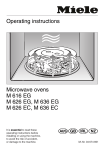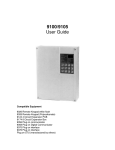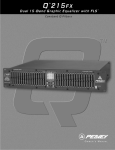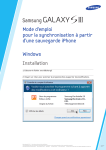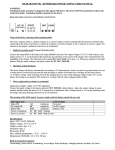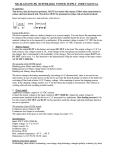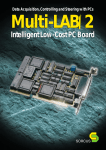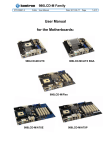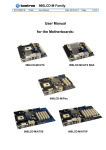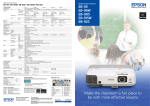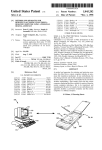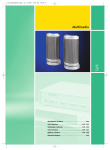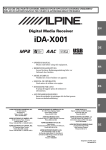Download Serial communication with PCs
Transcript
Serial communication with PCs Multi-COM The intelligent 6-channel serial PC board 1 Multi-COM The communication allrounder Modern-day automation technology includes numerous tasks excellently suited for PC pro- Sophisticated protocol handling may substantially downgrade a PC’s performance, cessing. However, the two lonely RS-232 especially when more than one interface has standard interfaces with which a PC usually provides do not exactly predestine it for so- to be served simultaneously. If in addition to this, real-time requirements also apply for ■ Intelligent PC board with its own CPU and peripherals phisticated communication services. More- certain processes, the usual PC standard ■ The board’s local CPU works in over, it is mostly the more powerful variants of the RS-422 or RS-485 type which are re- hardware/operating system configuration will definitely soon come up against its limits. parallel with the PC’s CPU ■ Available with 486 or 586 CPU, up quired for industrial purposes, with electrical In cases like this, the most expedient techni- isolation where necessary. In place of absolute voltage levels, these latter work with dif- cal option is to assign time-critical tasks and communication sequences to a subsystem ferential voltages, thus rendering them less operating in parallel, thus freeing sufficient susceptible to interference as well as enabling them to bridge significantly longer dis- computing capacities on the PC for the user interface to save, evaluate and graphically ■ Watchdog, NMI and RAM buffering logic on-board tances. edit the results. ■ 10 timers, each with interrupt ca- Block diagram of the Multi-COM board Special characteristics to 133 MHz ■ Up to 34 MByte RAM: DRAM (8 or 32 MByte) and bufferable SRAM (512 kByte or 2 MByte) pability ■ Time and date (real-time clock) ■ 6 serial interfaces: async, sync, HDLC, monosync, bisync, and other protocols pos- RAM sible (baudrate generator and St1 S-Link ROM configurable SCC (customer-specific as well): RS-232, RS232 iso., RS-422, RS- S-Link EEPROM DPLL for each channel) ■ 5 hardware interfaces individually 422 iso., RS-485, RS-485 iso., 20 mA iso., CAN iso., PROFIBUS iso., optical-fiber link ■ 1 RS-232 interface S-Link 486-CPU ■ OsX real-time multi-tasking operating system on-board (in the SCC Watchdog Timer Clock Interrupt Controller S-Link EPROM or in the Flash EPROM) ■ Drivers for MS-DOS, Windows 3.x, Windows 95, 98 and NT included in the package S-Link SCC ■ Communication protocols available, e.g. 3964/R St2 RS-232 ■ Libraries for developing user protocols included in the scope of delivery St3 ■ 100 % compatible with MODULAR-4/486 with 2 or 3 M-COM-2 modules ■ Short PC board for 16-bit ISA slot, PC interface 2 option for stand-alone operation (without PC) Local CPU, Temperature and fan up to 133 MHz 10 timers monitoring 5 multi-purpose serial interfaces, configurable with S-Links Possible physical interfaces: ■ RS-232 and RS-232 iso. Real-time ■ RS-422 and RS-422 iso. multi-tasking operating system ■ RS-485 and RS-485 iso. ■ 20 mA iso. ■ Optical-fiber link ■ CAN iso. ■ PROFIBUS iso. ■ etc. RS-232 up to 34 MByte RAM Clock, watchdog Intelligent basis The Multi-COM board for the ISA bus contains a complete computer with comprehensive peripherals on a PC expansion board. The board can work independently of the PC, an option for implementing a fiber-optic inter- of SORCUS boards, is the Multi-COM board’s face. The S-Links’ job is to match the respec- compatibility with the widely used MODULAR-4/486 boards from SORCUS. The Multi- tive signal levels and to provide electrical isolation for the interfaces. A total of five S- COM board basically corresponds to a Links can be plugged on. sible (up to 8 boards in one PC). A 486 or 586 CPU (clock frequencies cur- MODULAR-4/486 board, which is fitted with three M-COM-2 communication modules. S-Links for the Multi-COM The serial interfaces have been implemented rently up to 133 MHz) operates on the Multi- ■ RS-232, RS-232 iso. COM board; this CPU can be used for processing communication protocols, for ex- with a total of 3 SCC building blocks (Z85C30 resp. Z85230; extended version with larger ■ RS-422, RS-422 iso. FIFOs). And a programmable quartz oscillator ample. A static and/or dynamic RAM serves ■ RS-485, RS-485 iso. for storing the communication programs and for buffering transmit/receive data. The board for the communication interfaces is additionally provided on the Multi-COM. ■ 20 mA (current loop) is available with a max. RAM size of 34 ■ Optical fiber MByte. An EPROM contains the Multi-COM board’s operating system. A watchdog timer, ■ CAN iso. (CAN-controller incl.) monitoring features for the fan, CPU-tem- ■ PROFIBUS iso. (Slave-controller incl.) multi-tasking operating system for up to 1024 perature and operating voltage ensure an appropriate response to any error occurring. For ■ SSI iso. (2 channels) tasks. This operating system is used on all SORCUS boards and is excellently suited not meaning genuine parallel processing is pos- example, important data can still be saved in the event of a power loss. 10 timers, each with interrupt capability, are also provided, as is a real-time clock for date and time (likewise bufferable). The Multi-COM board can also be run in stand-alone mode. Configurable interfaces The board contains a total of 6 serial communication interfaces and can be used for even the most complex communication jobs. For instance, it can be equipped with RS-232, RS422, RS-485, CAN, etc. since the communication interfaces can be configured channel by channel using plug-on micro-modules, also referred to as S-Links. There is likewise Thus all existing programs are compatible, and can also be used on the Multi-COM board. The board’s EPROM contains a real-time The sixth serial interface is a complete RS232 interface with all modem control lines. Each interface possesses its own baudrate generator and a DPLL, with the following operating modes: asynchronous, synchronous, HDLC, SDLC, monosync, and bisync. A basic program for buffered serial communication is available for synchronous and asynchronous communication tasks. And numerous communication protocols are already available, too, such as 3964/R, etc. Compatible with MODULAR-4/486 A special advantage, particularly for those users already familiar with the programming only for communication jobs but also for other functions as well: for example, in addition to communication activities, further realtime programs for open- and closed-loop control as well as monitoring functions can be utilized, such as digital PID controllers, FastFourier transformations, etc. There is an option for writing your own programs intended to run as a task on the Multi-COM, using the familiar PC development environments, without the need for a specific development tool. Drivers for MS-DOS, Windows 3.x, Windows 95, 98 and Windows NT are also included in the Multi-COM board’s scope of delivery, as are libraries and DLLs for all commonly used high-level languages. 3 Multi-COM Technical data CPU 586 (133 MHz) or 486 DX2/66 RAM Max. 34 MByte static: 512 kByte or 2 MByte (battery-bufferable) dynamic: 8 MByte or 32 MByte ROM EPROM or Flash-EPROM, up to 512 kByte EEPROM 128 words, serial Timers 3 timers with a width of 16 bits, programmable input frequency 1 MHz, 2.5 MHz or 10 MHz, with interrupt capability; 6 timers in the SCCs and one in the real-time clock Serial interfaces 6, of which 5 configurable with S-Link (to 62-pin D-Sub connector); 1 RS-232 with all modem control lines (to 3-pin Mini-DIN plug connector and 20-pole plug connector) SCC 85C30 resp. ESCC 85230, programmable quartz oscillator Max. Baudrate 1.2 MBaud (async.), 5 Mbits/s (sync.), applies for EM-2224 and for EM-2592, see last page S-Link slots 5 Interrupts Max. 15, some of them also available externally Voltage Two response thresholds (4.8 and 4.65 V), NMI-triggering, buffering of RAM and real time clock monitoring Temperature The CPU temperature is measured and monitored (with interrupt triggering) monitoring Fan monitoring Speed monitoring with interrupt triggering and software-based fan control PC interface 16-bit parallel, bidirectional, with interrupt capability (locally and to the PC) Clock Date (day, month, year, weekday) and time (hours, minutes, seconds) bufferable with external battery, interrupt capability (1/64 sec., 1 sec, 1 min., 1 h) Multi-tasking Included in the board’s EPROM operating system With real-time capabilities, max. 1024 tasks, interrupt tasks, timer-initiated tasks, and non-interrupt tasks Power consumption +5 V (measured with 586-133 MHz, fan and LED off, without S-Links) +12 V 0.2 mA –12 V 0.2 mA –5 V Dimensions Board (measured without slot plate and D-Sub plug connector) Compatibility Temperature (optional) Humidity (not condensing) 4 1.8 A not connected 106 mm x 158 mm 0 to 55 °C (70°C) 5 to 95 % S-Links for Multi-COM SL-232S SL-232i SL-232A/i be configured. Installation and/or replacement of S-Links can be • RS-232 up to 220 kBaud • RS-232 isol. up to 220 kBaud • RS-232 up to 220 kBaud performed by the customer. S- • Modem control lines: TMT, RCV, RTS, CTS, DTR, DSR, RI, • Isol. modem control lines: TMT, RCV, RTS, CTS • Modem control lines: TMT, RCV, RTS, CTS, DTR, DSR, RI, The Multi-COM provides five slots for S-Links. S-Links are plugon micro-modules with a standard connection pattern for serial interfaces, which enables all commonly used signal levels to Links are available with or without electrical isolation. And there is also an option for plugging on a fiber-optic S-Link. S-Links are automatically recognized by the Multi-COM board, and the serial DCD • Additional functions: – CTS as clock input – RTS as clock output • Additional functions: – RI as clock input – CTS as clock input DCD • Additional functions: – Additional EXT RS-232 line as clock input 1 – RTS as clock output – RI as clock input 2 interfaces concerned are initialized appropriately. SL-232A/o SL-422 SL-422i SL-485 • RS-232 up to 220 kBaud • RS-422 up to 10 MBaud • RS-422 isol. up to 10 MBaud • RS-485 up to 12 MBaud • Modem control lines: TMT, RCV, RTS, CTS, DTR, DSR, RI, • Modem control lines: TMT, RCV, RTS, CTS • Modem control lines: TMT, RCV, RTS, CTS • Switchover from transmit to receive either under software • Additional functions: • Termination resistors can be control, or automatically (e.g. DCD • Additional EXT RS-232 line as clock output – CTS as clock input – RTS as clock output switched into circuit on the SLink for SDLC/HDLC) • Additional functions: – CTS as clock input – RTS as clock output SL-485i SL-20MA SL-LWL SL-CANi • RS-485 isol. • 20 mA isol. up to 38.4 kBaud • Current loop • Connection for plastic (SL- • With its own Intel CAN controller • Up to 12 MBaud • Suitable for PROFIBUS • Additional TTL output indicates transmit/receive, e.g. for ext. transceiver • 2 constant-current sources provided by the S-Link • Can be passively or actively configured (if passively, then electrically isolated) LWL/P) or glass fiber-optic link (SL-LWL/G) • Transmission rate of up to 1 Mbits/s • Cable length up to 1000 m • 11-bit and 29-bit identifiers • JIS plug connector system from Toshiba • Electrically isolated from the CAN bus • Including software 5 Programming High-level-language libraries and real-time ■ 5 to 8 data bits ■ 1, 1.5 or 2 stop bits Portability All the Multi-COM’s communication interfaces can be operated with a wide variety of ■ With or without parity (even or odd) for the various PC operating systems, which protocols. Those available from SORCUS include, for example, 3964/R, GE Fanuc, and ■ Handshake per XON/XOFF or with RTS/ CTS means that a particular application program (once it has been developed) can easily be Bosch LSV2. ■ Baudrates of 110 to 115,200 Baud ported onto a different operating system. There is also an option for developing your own protocols. Each serial interface provides ■ Size of the transmit and receive buffers can be set Scope of delivery Protocols The functionality of the libraries is the same All high-level-language libraries, plus the cor- its dedicated baudrate generator and a DPLL. The possible operating modes are as follows: asynchronous, synchronous, HDLC, SDLC, An application program or a superimposed protocol software package accesses the ba- responding drivers, are included in the boards’ scope of delivery. The current library Monosync, and Bisync. When the appropri- sic communication facility with function calls. versions are also available at any time in the ate S-Links are plugged on, PROFIBUS and CAN can also be implemented. For this Basic communication functions can be utilized both by PC and real-time programs on Internet (www.sorcus.com), free of charge. The operating systems and compilers sup- purpose, SORCUS supplies ready-to-use the board. All the requisite commands are ported are included in the listing below, to- communication programs, which facilitate integration into the software. included in the high-level-language libraries supplied with the board. You can use similar gether with their versions. If the compiler you’re using is not mentioned there, please libraries for the Multi- get in touch with SORCUS. COM board as for the MODULAR-4/486 board. High-level-language libraries These offer the operator a user-friendly interface for communicating from the PC with Multi-COM boards and Operating systems and programming languages supported: MS-DOS ■ Borland C (as from Version 3.1) ■ Microsoft C (as from Version 8.0) ■ Watcom C (as from Version 10.0) ■ Borland Pascal (as from Version 6.0); also Protected Mode are available for a variety of programming languages, like C, Pascal and BASIC, and for The SL-CANi CAN bus S-Link Synchronous and communication different operating systems, such as MSDOS, Windows 3.x, Windows 95, 98 and asynchronous A basic program (CQ6) for buffered serial communication is available for synchronous and asynchronous communication jobs. You can implement user-specific protocols very easily on the basis of this software. Basic communication is set up on the PC using a utility program, and installed on the MultiCOM board. At the bottommost level, the CQ6 supports the following settings (e.g. for asynchronous communication): 6 Windows NT. You can serve up to eight boards from one library. The libraries handle the following tasks: ■ configuring the board ■ loading real-time programs onto the board ■ data exchange between board and PC ■ error handling ■ interrupt handling Windows 3.x ■ Borland C (as from Version 3.1) ■ Borland Pascal (Version 7.0) ■ Borland Delphi (as from Version 1.0) ■ Microsoft Visual Basic (as from Version 3.0) ■ Microsoft Visual C (as from Vers. 1.0) ■ Watcom C (as from Version 10.0) Windows 95, 98 and Windows NT ■ Microsoft Visual C (as from Vers. 4.0) ■ Borland C (as from Version 5.0) ■ Microsoft Visual Basic (as from Vers. 4.0) ■ Borland Delphi (as from Version 2.0) ■ DASYLab Under preparation: ■ LabView drivers (1Q99) programming, protocols, CAN user, since you can access Borland’s and Microsoft’s standard compilers (Pascal or Structure of real-time programs All SORCUS boards provide their own microprocessor running an operating system with C++) during programming. A specific devel- real-time capabilities: OsX. This enables genuine parallel processing with the PC to be opment environment is not necessary. that of a DOS program, except that the program code has been subdivided into what are implemented, which is more or less essen- Developing your own programs tial if data are to be acquired and processed in real time, especially when modern-day PC To develop your own real-time programs, you have to proceed in three steps: Real-time programming called task procedures. Task procedures can operating systems like Windows 98 or NT are being used. Data-acquisition and communication tasks can be run on the board in com- 1. Enter and compile the real-time program concerned under Microsoft or Borland plete independence of the PC, thus freeing your PC to handle other tasks, like visualization and storage jobs. A real-time program’s structure resembles C++ or Borland Pascal. 2. Transfer the program onto the Multi- The OsX multi-tasking operating system en- COM board. be called from other tasks on the board or from the PC as well, e.g. to start or abort transmit or receive functions. In addition to the task procedures, the program also comprises what are called the parameter area and the data area. The parameter area will normally contain configuration and parameterizing data definable by the user, like baudrate, parity, etc. The data area can be used to accommodate the user data. As with the task procedures, here too, other ables more than one process (task) to be executed simultaneously on a single board. 3. Test and debug the real-time program tasks on the board and the PC can very easily Real-time programs running as tasks on the with the Borland source code debugger board are very easy to program for you as the (remote debugging). access parameters and data. The Multi-COM board’s libraries provide a variety of functions for this purpose. The completely compiled real-time program can be transferred onto the Multi-COM board Call User data either with the PC utility programs supplied Task 3 Task 2 Transmission object 2 M049TASK calls associated procedure/task or from one of the user programs by means of the PC libraries supplied. Transmission object 3 Task 4 Debugging real-time programs You can use the ‘Turbo-Debugger’ from Borland to test the real-time program developed exhaustively. This debugger enables a real-time program to be debugged just like a Reception object 4 PC program, at the source code level. All the Task 1 Task x M049TASK Turbo-Debugger’s features, such as breakpoints, watch variables, etc. are of course available for this purpose. Multi-COM Transmission object x Reception object 1 CAN You must install the M049TASK driver soft- SL-CANi with CAN-Controller SL-CANi receives message and calls M049TASK CAN controller on the S-Link, M049TASK CAN bus MESSAGE-X ware supplied on the Multi-COM for operating the SL-CANi S-Link. Together with the MESSAGE-1 MESSAGE-Y ensures that messages are received and transmitted over the CAN bus. The application software communicates with Messages are sent via the CAN bus. SL-CANi receives and transmits messages. The messages are supplied from and to M049TASK. M049TASK passes on the user data received from the associated applications, or M049TASK by function calls, which can be made both from the PC and from the board forwards user data to the associated applications. (in real-time). 7 Fax Order Form to ++49-(0) 62 21-32 06-66 Company Date Name/Department Please print name P.O.Box/Street Ordering No. City/Post Code Signature/Stamp Ordering No. Qty. Brief description Price/piece Multi-COM with 6 serial interfaces (S-Links must be ordered separately.) EM-2140 Multi-COM: intelligent PC board with a 486-DX2 CPU (66 MHz internal), 512 kB static RAM, including fan, manual and connector EM-2173 Multi-COM: intelligent PC board with a 586-133 CPU (133 MHz internal), 2 MB static RAM, including fan, manual and connector EM-2224 Multi-COM: intelligent PC board with a 586-133 CPU (133 MHz internal), ESCC 85230, 10 MB RAM (2 MB static and 8 MB dyn.), including fan, manual and connector EM-2592 Multi-COM: intelligent PC board with a 586-133 CPU (133 MHz internal), ESCC 85230, 34 MB RAM (2 MB static and 32 MB dyn.), including fan, manual and connector S-Links for Multi-COM FM-2230 SL-20MA: S-Link for a 20-mA serial interface, current loop active or passive (if passive, then electrically isolated) FM-2231 SL-232S: S-Link for an RS-232 serial interface FM-2324 SL-232A/i: S-Link for an RS-232 serial interface, additional CLK-input FM-2325 SL-232A/o: S-Link for an RS-232 serial interface, additional CLK-output FM-2232 SL-232i: S-Link for an RS-232 serial interface, electrically isolated FM-2233 SL-422: S-Link for an RS-422 serial interface FM-2234 SL-422i: S-Link for an RS-422 serial interface, elecrically isolated FM-2237 SL-485: S-Link for an RS-485 serial interface FM-2238 SL-485i: S-Link for an RS-485 serial interface, electrically isolated FM-2268 SL-DPSi: S-Link for a PROFIBUS-DP slave connection, electrically isolated FM-2269 SL-CANi: S-Link for CAN bus, electrically isolated FM-2270 SL-2SSli: S-Link for 2 synchronous serial interfaces ( ’Stegmann’ compatible, 2 channels) FM-2585 SL-TEST: S-Link for testing all other S-Links Manuals and Software (One FM-2226 Manual is included in the board’s scope of delivery.) FM-2181 Additional User Manual for the Multi-COM (German) FM-2226 Additional User Manual for the Multi-COM (English) SW-1442 3964/R protocol (Siemens S5), single licence (general lincence on request) MA-1529 User Manual for the SCC (85C30 and 85230) (English) Accessories for Multi-COM (One FM-2229 plug connector is included in the board’s scope of delivery.) K2-6259 Shielded cable, 1.5 m long, for the Multi-COM, one end with 62-pole D-Sub- K3-6260 Shielded cable, 3.0 m long, for the Multi-COM, one end with 62-pole D-Sub- FM-2229 Additional 62-pole D-Submin. plug connector with hood for the Multi-COM K2-4003 Serial connection cable for Interface B (debug cable), 1.5 m long, min. plug connector, the other end with five 9-pole D-Submin. plug connectors min. plug connector, the other end with five 9-pole D-Submin. plug connectors 3-pole Mini-DIN to 9-pole D-Sub. K3-5003 Serial connection cable for Interface B (debug cable), 3.0 m long, 3-pole Mini-DIN to 9-pole D-Sub. Your local distributor: Total amount + dispatch charges + VAT Sum total of invoice SORCUS Computer GmbH Im Breitspiel 11, D-69126 Heidelberg Phone 0 62 21/32 06-0 Fax 0 62 21/32 06-66 Hotline 0 62 21/32 06-32 www.sorcus.com 8 Total price








